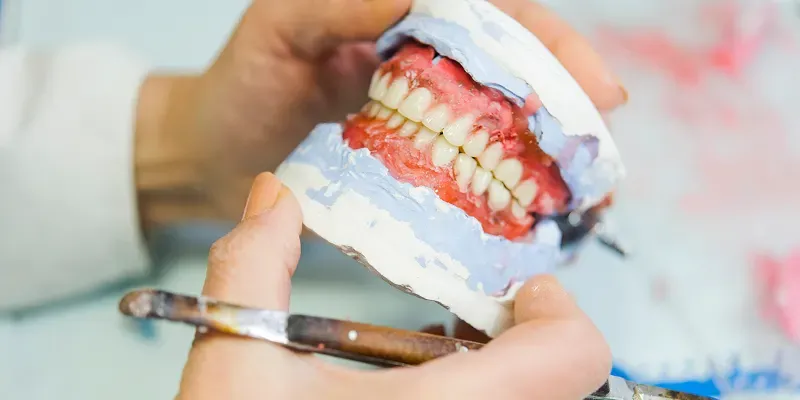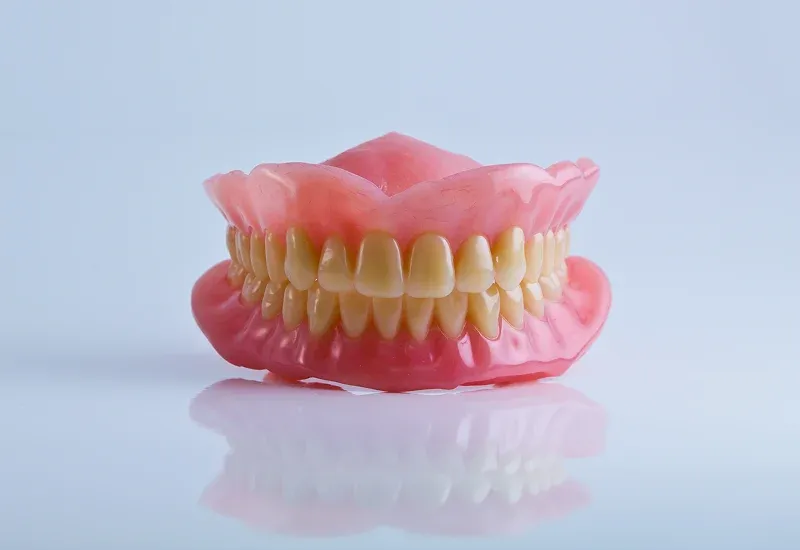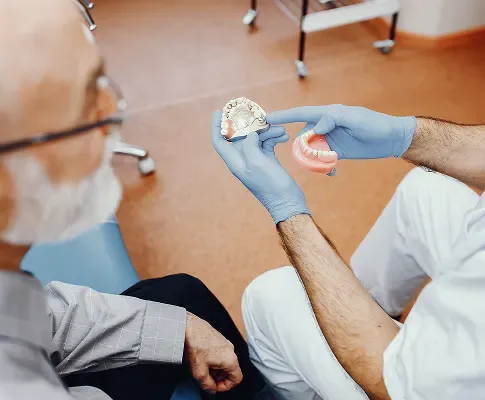
How Dentures Are Made: The Step-by-Step Process Explained
Dr. Azadeh Hosseini
21 July 2025
When it comes to restoring your smile and oral function, custom dentures offer a life-changing solution. But while wearing dentures may seem straightforward, many patients are curious about the actual denture making process. Questions like “how do they make dentures?” or “what happens during denture fitting?” are becoming more common as dental patients become more informed. This blog takes a closer look at how dentures are made, with a complete walkthrough of each stage involved in creating dental lab dentures—from the first impression to the final fitting.

Understanding the Basics: What Are Dentures?
Before we dive into the denture fabrication journey, it’s important to understand what dentures are. Dentures are removable prosthetic devices designed to replace missing teeth and surrounding tissues. Unlike dental implants, custom dentures are crafted to fit the unique shape and function of your mouth, which is why the entire process is carefully tailored for each individual.
The Denture Making Process: Step-by-Step Overview
The creation of dentures is a multi-step procedure that combines clinical precision with skilled craftsmanship, usually performed in a prosthodontic lab. Here's a detailed breakdown of how dentists and technicians collaborate during the steps to get dentures.
1. Initial Consultation and Dental Impressions
The journey begins with an oral examination, where the dentist evaluates your overall dental health and bone structure. Once you're approved for dentures, the first physical step involves taking dental impressions. These molds are used to capture the contours of your gums, teeth (if any remain), and palate.
- Primary Impressions: A basic mold to understand the mouth’s general structure.
- Final Impressions: Made using a custom tray to capture finer details necessary for accurate denture modeling.
This data is then sent to the prosthodontic lab, where technicians begin creating a model of your mouth.
2. Bite Registration and Jaw Relation
At your next appointment, your dentist will determine how your upper and lower jaws align. This is done using wax blocks, often referred to as bite rims, which help record how your jaws come together. This step is critical in ensuring the final dentures allow for a natural bite and speech function.
The information from this phase is essential for denture fabrication, allowing the lab to position artificial teeth in the correct location.
3. Tooth Selection and Setup
The dentist helps you choose the size, shape, and color of your new teeth, ensuring they match your facial features and aesthetic preferences. This process is highly personalized and contributes to the appearance of custom dentures. The selected artificial teeth are then set into a wax base to prepare for the next phase.
4. Wax Try-In: Your First Glimpse of the Denture
One of the most exciting phases in the denture making process is the wax try-in. This is a temporary version of your dentures created in wax so you can try them on before they are finalized.
During this stage:
- You can assess the fit, feel, and appearance.
- Adjustments are made based on your feedback.
- The dentist checks for proper alignment and bite.
This step answers many patients' questions, such as “what happens during denture fitting?”, and allows for early customization before the final denture is crafted.
5. Final Denture Fabrication at the Dental Lab
Once the wax model of the dentures is approved by the dentist and patient, it is sent back to the dental lab for final fabrication. This is a critical stage where the wax version is transformed into a permanent, durable denture. Skilled technicians at a prosthodontic lab replace the wax with high-quality acrylic resin through heat-curing processes, ensuring the final base is strong and long-lasting. The dentures are then carefully polished to enhance their appearance and provide a smooth, comfortable fit. Before returning them to the dental office, the lab conducts thorough quality checks to confirm bite accuracy and overall fit. This professional fabrication process is essential to delivering dentures that are both functional and aesthetically pleasing
6. Final Fitting Process and Adjustments
After the dentures return from the lab, it's time for your fitting process. At this stage, your dentist checks the final product for comfort, fit, and aesthetics. Minor adjustments may be needed to eliminate pressure points or rough edges.
Many patients wonder, “how long to make dentures?” Typically, the process—from impression to final fitting—takes about 4 to 6 weeks, depending on the dental practice and lab efficiency. However, the timeline may vary based on your oral health, healing, and any prior treatments.
Do Dentists Make Dentures?
A common misconception is that dentists themselves manufacture dentures. While dentists oversee the procedure and perform fittings, the actual construction is carried out in a prosthodontic lab by certified dental technicians. So, in essence, do dentists make dentures? They coordinate the process but rely on lab technicians for fabrication.
Advancements in Denture Fabrication: The Digital Era
As dental technology evolves, so does the denture fabrication process. Today, digital workflows have transformed how dental lab dentures are made, leading to faster turnaround times, enhanced accuracy, and better comfort.
Digital Denture Modeling
Digital scanners now replace traditional physical dental impressions in many practices. These 3D scans are sent directly to a prosthodontic lab, where CAD (Computer-Aided Design) software creates virtual models. These files guide the production of custom dentures using 3D printing or milling machines.
Benefits of Digital Denture Making
Improved Fit
3D digital modeling allows for precise bite registration and jaw alignment, leading to dentures that fit more comfortably and securely. Unlike traditional methods that rely on manual impressions, digital scans capture fine anatomical details, helping to reduce sore spots, slipping, or the need for constant adjustments. This accuracy enhances both function and comfort, resulting in a more natural-feeling fit for the patient.Speed
Digital denture production significantly reduces turnaround time. Once the digital impressions and designs are approved, many dental labs can fabricate the final dentures within just a few days—sometimes even faster than traditional methods. This is especially beneficial for patients who need quick replacement or immediate full-arch restorations without long waiting periods.Replicability
One of the key advantages of digital dentures is the ability to store patient records securely in digital form. If a patient loses or damages their dentures, a replacement can be quickly created without needing new impressions or fittings. The saved digital files make it easy to reproduce the exact shape, fit, and bite of the original set, offering convenience and peace of mind.
With the help of digital technologies, the denture making process is becoming more efficient while maintaining clinical precision.
After the Denture Fitting: What to Expect Next
Once the final set is delivered, you begin the adaptation phase. This period is critical, especially for first-time wearers.

Need Any Help?
Contact UsWhat Happens During a Denture Fitting?
Your dentist will guide you through the initial adjustment period, ensuring proper placement, checking bite, and identifying pressure spots. If needed, follow-up visits are scheduled to fine-tune the fit.
Post-Fitting Tips for Comfort
- Practice speaking to get used to the new prosthesis.
- Eat soft foods initially and gradually reintroduce harder textures.
- Use prescribed adhesives (if needed) as per your dentist’s guidance.
- Regular cleaning is essential to prevent irritation or infection.
These steps help patients feel more confident as they adjust, especially after wondering, “how do they make dentures that feel so real?”
How Long to Make Dentures: Timeline and Expectations
Patients often ask, “how long to make dentures?” While each case is unique, here’s a typical breakdown:
Initial Consultation to Final Fitting
Traditional dentures usually take about 4 to 6 weeks, involving multiple visits for impressions, try-ins, and adjustments to ensure proper fit and function.Digital Dentures
Thanks to advanced scanning and CAD/CAM technology, digital dentures can be completed in as little as 1 to 2 weeks in clinics equipped with in-house or fast-turnaround labs.Immediate Dentures
Immediate dentures are placed right after tooth extraction, providing same-day results. However, they often require follow-up adjustments as the mouth heals and reshapes.
Several factors affect this timeline, including healing time (if teeth were recently extracted), the number of adjustments needed, and the lab’s workflow.
Conclusion
The process of how dentures are made is both scientific and artistic. From the first dental impression to the final denture fitting process, every stage is tailored to deliver a natural-looking, functional smile. Whether using traditional methods or advanced digital workflows, the denture making process today focuses on comfort, customization, and long-term wearability. While dental lab dentures may take time to craft, the result—a confident, fully restored smile—is worth every step. So, the next time you hear someone ask, “how do they make dentures?” or “do dentists make dentures?”, you’ll know there’s a complex, collaborative process behind every set of custom dentures.
Contact your Concord dentist, Dr. Azadeh Hosseini, DDS, at Top Concord Dental to learn more about How Dentures Are Made: The Step-by-Step Process Explained.
Resource:
Is Restorative Dentistry Right for You? What to Know Before Deciding
Disclaimer
*This media/content or any other on this website does not prescribe, recommend, or prevent any treatment or procedure. Therefore, we highly recommend that you get the advice of a qualified dentist or other medical practitioners regarding your specific dental condition. *
